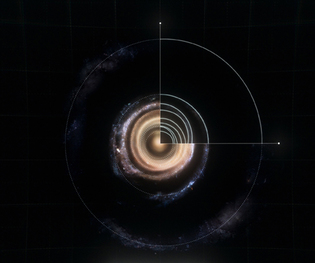
Nasa, ESA, RALF Crawford (STSCLI)
The “Bullseye” galaxy, LEDA 1313424, got its nickname when Yale researchers spotted its nine rings.
View full image
Since the first galaxies formed more than 13 billion years ago, the universe has been something of a cosmic bumper-car arena. But most of the collisions are glancing blows that leave little visual trace.
About 50 million years ago, however, a massive galaxy named LEDA 1313424 suffered what astronomers consider a rare direct hit when a dwarf galaxy slammed right through its center. The slow-moving collision in the constellation Pisces some 567 million light years away from our planet left behind an unmistakable signature—at least nine starry rings within LEDA and a deformed dwarf galaxy now trailing a faint train of galactic gas. Until recently, no one had noticed.
When astronomy department graduate student Imad Pasha ’25PhD serendipitously started comparing two sets of survey images, one taken by Yale’s Dragonfly telescope and another captured by other scopes, on February 8, 2022, he saw it.
“Something stood out to me,” says Pasha, who finished his doctoral studies last December. “It had an unusual color gradient and a bullseye-like appearance. I could see three rings clearly, and that grabbed my attention.”
Pasha wasn’t alone. When he told his mentor, Pieter van Dokkum, the Sol Goldman Family Professor of Astronomy and Dragonfly’s codesigner, about his discovery, van Dokkum’s immediate response was “Wow!” The researchers moved rapidly to apply for observation time on the more powerful Keck and Hubble telescopes, and the images they obtained fully justified dubbing LEDA the “Bullseye” galaxy. The two researchers and their colleagues published their work in The Astrophysical Journal Letters, showing unprecedented and visually stunning structural details of what’s known as a collisional ring galaxy (CRG).
Scientists had known of the existence of CRGs since 1941, when astronomer Fritz Zwicky published photos of the so-called Cartwheel, but since then skywatchers had only found a handful of structures in which collisions had forged a few star-forming rings of compressed gas and dust. With LEDA, researchers had observational data that corroborated theories about galaxy formation and evolution.
“It all fits beautifully,” says van Dokkum, adding that they suspect there may be an even fainter tenth ring circling the Bullseye. The researchers predict that the rings will eventually expand like the ripples of a stone thrown into a pond and reshape LEDA, perhaps into a rare ultra giant galaxy.
“The universe is full of wonders,” says van Dokkum, highlighting the critical importance of old-fashioned observation techniques. “Imad found this galaxy by looking with his eyes. That’s still extremely powerful.”
 loading
loading